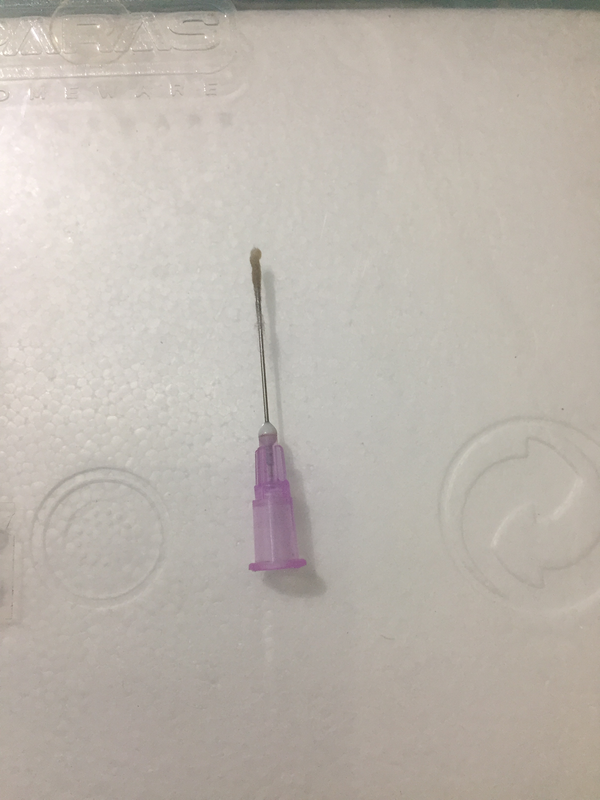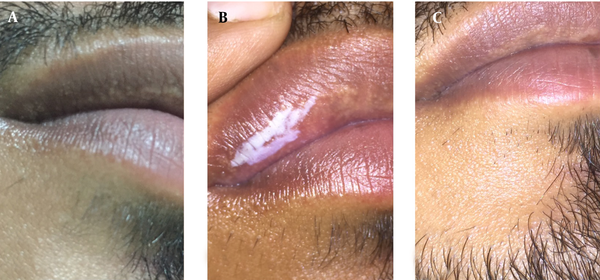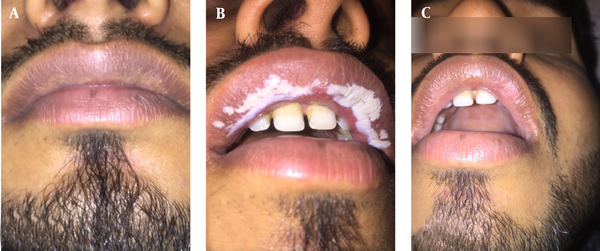Dear Editor,
Fordyce spots are asymptomatic yellowish micro-mini papules due to the presence of heterotopic sebaceous glands over the lip. The spots create a cosmetic issue in some individuals. In this regard, several therapeutic modalities have been proposed, such as laser, electrical or chemical ablation, micropunch excision, and intralesional electrocoagulation with insulated microneedle radiofrequency probe (1, 2). However, these modalities pose a risk of scarring from inevitable surface damage. In addition, these modalities are time-consuming and cumbersome. Here, we described precise chemical cauterization with needle cotton bud to avoid inevitable tissue injury and scarring.
Under asepsis, before cauterization of the whole lesion, spot chemical cautery with trichloroacetic acid (TCA; 100%) was performed using a cotton-tipped hypodermic needle to judge the tissue damage, healing time, and cosmetic defect at the site (Figure 1). The lesion healed after 10 to 14 days (Figure 2A-C). Then, the whole lesions of Fordyce spots were cauterized in the same way (Figures 3A and B). After cauterization, the patient was prescribed topical antibiotics and moisturizer for 1 to 2 weeks. The lesions healed within 2 weeks without residual side effects of cautery (Figure 3C). Being caustic, TCA must be used with all precautions and should be applied precisely to lesions. On intact skin and mucosa, TCA penetrates up to the upper part of the papillary dermis as it precipitates the epidermal protein; accordingly, deeper tissue is sealed from injury, which is not with phenol. After cauterization, for fast healing and minimal scar, the site should be kept moist and free from infection and scab removal tendency by the patient. However, a spot test of the cautery should be done to judge the nature of healing and scar formation on the site. Thus, TCA cautery is a good, cost-effective, readily available option for treating prolabial Fordyce spots. Further studies with large sample sizes and a wide range of skin types are required for judging the effectiveness of the TCA cautery.
A cotton tipped hypodermic needle soaked in TCA.

A-C, Spot chemical cautery was done before treating Fordyce’s Spots.

A, B, TCA cautery was done after 2 weeks of spot cautery. C, Fordyce’s spots after 2 weeks of TCA cautery.

References
-
1.
Ahn GR, Park SJ, Lee CK, Kim BJ. A case of successful treatment of Fordyce spots with a single insulated microneedle radiofrequency device. Dermatol Ther. 2019;32(5). https://doi.org/10.1111/dth.13026.
-
2.
Ryu SI, Jeong JY, Kim KE, Ryu HJ. Fordyce Spots Treated by an Intralesional Insulated Microneedle Radiofrequency Device. Dermatol Surg. 2020. https://doi.org/10.1097/dss.0000000000002868.
